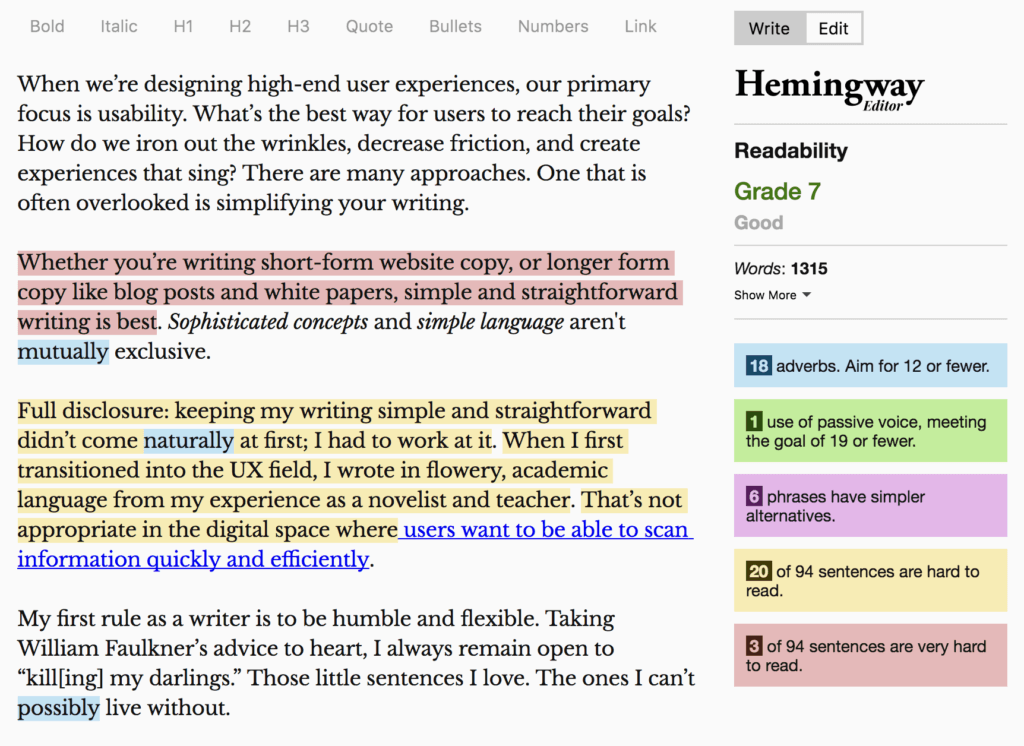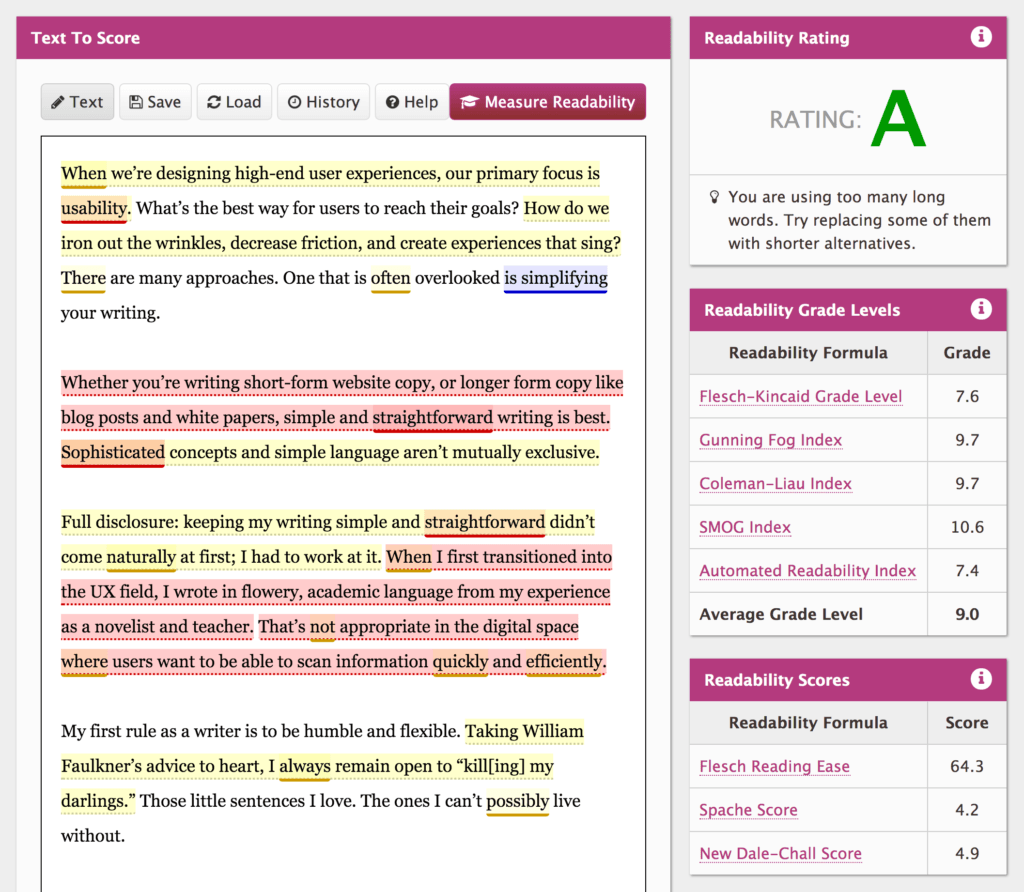Article
5 Ways to Simplify Your Writing for the Web

When we’re designing high-end user experiences, our primary focus is usability. What’s the best way for users to reach their goals? How do we iron out the wrinkles, decrease friction, and create experiences that sing? There are many approaches. One that is often overlooked is simplifying your writing.
Whether you’re writing short-form website copy, or longer form copy like blog posts and white papers, simple and straightforward writing is best. Sophisticated concepts and simple language aren’t mutually exclusive.
Full disclosure: keeping my writing simple and straightforward didn’t come naturally at first; I had to work at it. When I first transitioned into the UX field, I wrote in flowery, academic language due to my experience as a novelist and teacher. That’s not appropriate in the digital space whereusers want to be able to scan information quickly and efficiently.
My first rule as a writer is to be humble and flexible. Taking William Faulkner’s advice to heart, I always remain open to “kill[ing] my darlings.” Those little sentences I love. The ones I can’t possibly live without.
The same advice applies when writing for the web: keeping it simple and succinct. Amazing user experiences lie at the intersection of content and design. If you’re invested in creating content experiences that stand in service to the end user, always remain open to killing your darlings. Here’s how:
Tool #1: Google Drive – Organize Your Process!
How can a cloud-based file storage system simplify your writing? My answer: it simplifies the process, which in turn simplifies the product.
I love organizing my writing in folders. To keep my thought process streamlined, I keep my folder structure simple – research, outlines, notes, and drafts:

When constructing a white paper (truly a building process) I draft in a Google Doc. It’s shareable, so multiple people can weigh in on drafts and progress over time. However, a doc can become a chaotic mess when each collaborator starts adding links, or copying and pasting text from related articles.
By organizing folders up front, I’m able to navigate between documents with ease. This allows me to focus on keeping the writing itself clear and simple. If your desk is messy, chances are your product will be messy too. That’s something you can’t afford when writing for the web, where capturing the user’s attention with clean copy is key.
Tool #2: Grammarly – Check Your Grammar!
Writers aren’t superhuman. Even if you don’t consider yourself a “writer,” there are plenty of tools that can help hone your work. Everyone can write, but nothing detracts from your good ideas more than poor spelling and bad grammar.
I love browser-based Grammarly because it’s easy to use and I’m able to monitor whether or not my writing is grammatically correct in real-time. It decreases the effort you’ll spend editing and revising down the line.
You can use Grammarly as you write, or cut and paste your work for a full check. I recommend using it from the outset. Then, when you use the other tools mentioned in this post, you’ll already have accurate grammar and syntax. That said, I also recommend always having another writer proofread your material before it’s published.
Think of Grammarly as your first line of defense. It allows you to ensure that your writing rests on a firm foundation from the get-go. And, if you want more information when researching key grammar concepts, consider checking out Grammar Girl or Grammarist.
Tool #3: Hemingway App – Like Hemingway, Keep it Simple and Direct!
Ernest Hemingway had a knack for keeping his writing dead simple. It turns out that writers who focus on simplicity can win Pulitzer Prizes too!
The Hemingway App allows you to make your writing bold and clear (though, using it doesn’t guarantee you’ll win any awards). There’s a free online version that’s powerful enough to help me focus on writing with an active voice. Using it also helps me keep my sentence structure simple and avoid unnecessary adverbs.

There’s a more robust desktop version too. It costs $19.99, but it carries the benefit of allowing you to use the tool without having an internet connection. It also adds the ability to share edits with colleagues, sort of like Google Docs. Additionally, you can publish directly to content management systems like Medium and WordPress.
Tool #4: Readable.io – Make Your Writing Readable!
I love that Readable gives my writing a grade! After entering text or the URL of your website into the Readable application, you’ll get an A through F grade. It’s sort of like high school, but way more fun, and definitely more forgiving in that you can modify your writing and watch your grade magically improve.
The grade results from the application scoring your writing against useful readability indexes like Flesh-Kincaid and Gunning Fog.
Depending on your audience, you’ll want to keep your writing at a certain grade level. For online audiences, the recommended target is 8th grade or below. This isn’t to say that online audiences are uneducated. It simply means that people want to consume and digest information fast, without doing a ton of cognitive heavy lifting.
Readable also has a built in text analysis tool that functions like the Hemingway App. The key difference is that, at a minimum, Readable costs $3 a month. You get a few free entries per day, but after that, you have to pay for the service.
It’s an expensive tool, but knowing where your writing scores on different indexes is useful.
Tool #5: A Pen and Paper – Use the Old-Fashioned Approach!
Still having trouble keeping your writing simple? Try getting back to basics, putting pen to paper.
This might sound crazy, but writing a post by hand can help you hone in on exactly what you want to say. Due to the technological miracle of portable computers, most of us are fast typists. But given our impulse to write flurries of words with reckless abandon, we often sacrifice simplicity.
Stephen King, my personal hero, once called his Waterman fountain pen “the world’s finest word processor.” After getting in a life-altering car accident, he was unable to sit at his computer. So, he started writing by hand. 
The value of writing by hand, as King puts it, is that “Instead of flying over the story, you’re forced to get down in the infantry.”
If you’re creating the first draft of a 20-page white paper, writing it by hand won’t be the most efficient use of your time. You might want to do a quicker fly over.
But, if you’re writing a one-thousand-word blog post, try approaching it the old-fashioned way. Get down into the trenches and write by hand. You’ll amaze yourself at how much more clean and concise your writing becomes when you’re forced to think carefully about each word you put on paper.
Looking for a recommendation for pens? I can’t speak to the Waterman fountain pen, but I’ll put a plug in for Zebras. In my humble opinion, they’re the best pens ever created.
Let’s Keep the Conversation Going
The tools mentioned in this post are only a few of the many available to writers. If you have tools you recommend, I’d love to hear about them.
The bottom line is, writing about sophisticated concepts in simple language is possible. Simple writing serves to relay complex ideas to your audience, with usability at top of mind.
Do you need writing services for your website? Give us a call. We love thinking about the needs of each individual client. And, most importantly, we love writing clean, high-end content that appeals to users and drives conversion.









